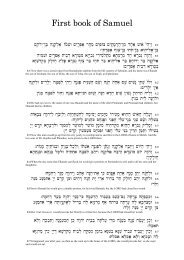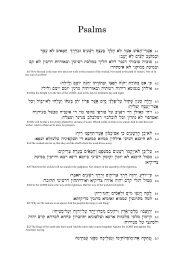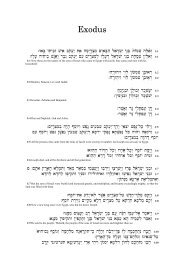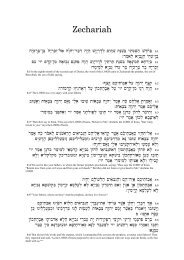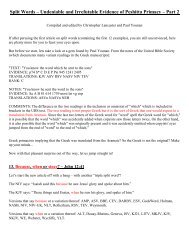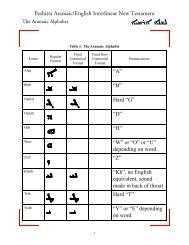ana translation
Untitled - Peshitta Aramaic/English Interlinear New Testament
Untitled - Peshitta Aramaic/English Interlinear New Testament
- No tags were found...
Create successful ePaper yourself
Turn your PDF publications into a flip-book with our unique Google optimized e-Paper software.
2 PET. i.<br />
4-5] SUPPLEMENTAL NOTES. 99<br />
but early hand has attempted to emend this by inserting 1 before a<br />
(and perhaps marking with ribbui), so that the word now stands as<br />
(y OifO. Hence the spurious reading ]'.' l ft of 2 (which codex is<br />
undoubtedly in this Epistle closely akin to 1)<br />
and of the later texts in<br />
general (except as above, 18(?), 19, 20, and Etzel's), including even that<br />
which is represented by the Arabic. This reading would obviously be<br />
the more readily adopted because of the occurrence of l''l ( Tip.rj)<br />
in vv. 1 (supr.)<br />
and 17 (infr.).<br />
Here again the remark suggests itself<br />
that, though the Harkl. supports rifua in common with 9, 12, 14, 19,<br />
these codices cannot have derived their text here by correction after that<br />
version ;<br />
for its rendering is not O (,' i > as theirs, but the cognate and<br />
equivalent |yO i V>. It is to be noted that this latter adjective is<br />
throughout the N.T. substituted by Harkl. for ;<br />
i<br />
Oi, which Pesh.<br />
like Philox. prefers. Similarly in the Apocalypse, the earlier (presumably<br />
Philox.) version (S) renders rt'/zios by >.Qa, and the later (2,<br />
presumably Harkl.) in every case substitutes ;OV).* Seeing that<br />
2 is evidently a revision of S, their usage as regards these two words<br />
serves to confirm the reading<br />
Ib.<br />
{','-*<br />
^* here.<br />
All copies of Philox. read ^OH\ (= vfuv, against nearly all Greek<br />
authorities see note on Gr. text in loc., p. 58). Harkl. in its text has<br />
^^ (= wlv, as all Gr. copies except A and 68), but adds the alternative<br />
tQ2,L in its<br />
margin ;t probably referring to the Philox. reading (vfjlv is<br />
rarely found in Gr. copies).<br />
See, for a like instance, Note on ver. 8 (infr.),<br />
5. Of our codices, 14 (Paris, 29) alone omits O1AD (=z Trao-av),<br />
but<br />
with some Gr. support. Harkl. inserts it, but (a only) with # prefixed<br />
(y diverges). This symbol may imply that the translator was aware of<br />
Gr. evidence for and against the word ; but (in view of such instances<br />
as those in vv. 4, 8, &c.) it is rather to be taken as signifying that iraaav<br />
was absent from his Gr. exemplar, but C1^2 was retained by him<br />
because he found it in Philox.<br />
* By the earlier (S) version is meant that edited by me (Dublin, 1897). The<br />
later (2) is that first edited by De Dieu (Leiden, 1627), and included in the<br />
Polyglots and. all subsequent Syr, New Testaments. For the grounds on which<br />
the former is to be accepted as Philoxeuian, and the latter as Harklensian, see<br />
Appendix III. infr.<br />
f Of the three codices of Harkl, distinguished as , 7, 8, collated in Appendix<br />
II. (infr.) with cod. a and White's text, and 7 give no marginal notes or<br />
textual marks ;<br />
5 (like a) gives several, in this place and elsewhere.



